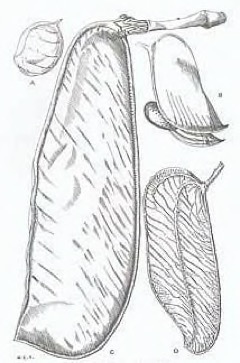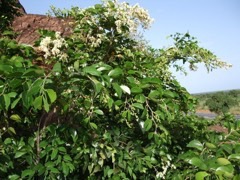 |
|
edibleplants.org |
 |
| © Barbara Eichhorn; African plants - A Photo Guide |
Translate this page:
Summary
Physical Characteristics

 Guibourtia copallifera is an evergreen Tree growing to 20 m (65ft) by 15 m (49ft) at a slow rate.
Guibourtia copallifera is an evergreen Tree growing to 20 m (65ft) by 15 m (49ft) at a slow rate.
See above for USDA hardiness. It is hardy to UK zone 10. The flowers are pollinated by Insects.
Suitable for: light (sandy) and medium (loamy) soils, prefers well-drained soil and can grow in nutritionally poor soil. Suitable pH: mildly acid and neutral soils and can grow in very acid soils.
It cannot grow in the shade. It prefers moist soil.
UK Hardiness Map
US Hardiness Map
Synonyms
Copaifera copallifera (Benn.) Milne-Redh. Copaifera copallina Baill. Copaifera guibourtiana Benn. Copaiva copallifera (Benn.) Kuntze Copaiva guibourtiana Lyons
Plant Habitats
Edible Uses
References More on Edible Uses
Medicinal Uses
Plants For A Future can not take any responsibility for any adverse effects from the use of plants. Always seek advice from a professional before using a plant medicinally.
The resin obtained from the tree is used for medicinal purposes[317 ]. The bark and leaves are also used medicinally[317 ].
References More on Medicinal Uses
The Bookshop: Edible Plant Books
Our Latest books on Perennial Plants For Food Forests and Permaculture Gardens in paperback or digital formats.

Edible Tropical Plants
Food Forest Plants for Hotter Conditions: 250+ Plants For Tropical Food Forests & Permaculture Gardens.
More

Edible Temperate Plants
Plants for Your Food Forest: 500 Plants for Temperate Food Forests & Permaculture Gardens.
More

More Books
PFAF have eight books available in paperback and digital formats. Browse the shop for more information.
Shop Now
Other Uses
The tree is a source of Sierra Leone copal, used in varnishes[46 , 317 ]. Copal is a hard resin, obtained from various tropical trees, that is used to make varnish[K ]. The wood has some resemblance to rosewood[316 ]. The heartwood is pink, vivid red, or red-brown with purple streaks or veins, on exposure becomes yellow or medium brown with a reddish tint[316 ]. The sapwood is whitish and clearly demarcated[316 ]. The texture is fine and even, the grain straight or interlocked, lustrous, sometimes highly figured[316 ]. It has an unpleasant odour when first cut which disappears on drying[316 ]. Though quite hard and heavy it works, saws, and planes rather well and produces a good finish, glues well[316 ]. The heartwood has good durability and is resistant to termite attack[316 ]. It is a good wood for turning, and is used to make fine furniture and cabinetwork, decorative veneers, fancy turnery, inlay work[316 ].
Special Uses
Carbon Farming
References More on Other Uses
Cultivation details
Industrial Crop: Hydrocarbon Industrial Crop: Medicinal Management: Standard Regional Crop
Although many species within the family Fabaceae have a symbiotic relationship with soil bacteria, this species is said to be devoid of such a relationship and therefore does not fix atmospheric nitrogen[755 ].
Carbon Farming
-
Industrial Crop: Hydrocarbon
Materials, chemicals and energy include bioplastics, rubber, biomass products gasoline, jet fuel, diesel, butane, propane, biogas. Plants are usually resprouting plants and saps.
-
Industrial Crop: Medicinal
Most pharmaceuticals are synthesized from petroleum but 25% of modern medicines are based on plants.
-
Management: Standard
Plants grow to their standard height. Harvest fruit, seeds, or other products. Non-Destructive management systems.
-
Regional Crop
These crops have been domesticated and cultivated regionally but have not been adopted elsewhere and are typically not traded globally, Examples in this broad category include perennial cottons and many nuts and staple fruits.
References Carbon Farming Information and Carbon Sequestration Information
Temperature Converter
Type a value in the Celsius field to convert the value to Fahrenheit:
Fahrenheit:
The PFAF Bookshop
Plants For A Future have a number of books available in paperback and digital form. Book titles include Edible Plants, Edible Perennials, Edible Trees,Edible Shrubs, Woodland Gardening, and Temperate Food Forest Plants. Our new book is Food Forest Plants For Hotter Conditions (Tropical and Sub-Tropical).
Shop Now
Plant Propagation
Seed
Other Names
If available other names are mentioned here
Gum-copal; true gum-copal; red gum; yellow gum; ‘gun copper’, pau ferro, pó de fero, kaki, mélamberi, u séra, é untu, yuntu, melámberi, bu mana, copalier; copalier de Guinea
Native Range
AFRICA: Côte D‘Ivoire, Guinea, Guinea-Bissau, Mali, Sierra Leone
Weed Potential
Right plant wrong place. We are currently updating this section.
Please note that a plant may be invasive in one area but may not in your area so it's worth checking.
None Known
Conservation Status
IUCN Red List of Threatened Plants Status : This taxon has not yet been assessed

Growth: S = slow M = medium F = fast. Soil: L = light (sandy) M = medium H = heavy (clay). pH: A = acid N = neutral B = basic (alkaline). Shade: F = full shade S = semi-shade N = no shade. Moisture: D = dry M = Moist We = wet Wa = water.
Now available:
Food Forest Plants for Mediterranean Conditions
350+ Perennial Plants For Mediterranean and Drier Food Forests and Permaculture Gardens.
[Paperback and eBook]
This is the third in Plants For A Future's series of plant guides for food forests tailored to
specific climate zones. Following volumes on temperate and tropical ecosystems, this book focuses
on species suited to Mediterranean conditions—regions with hot, dry summers and cool, wet winters,
often facing the added challenge of climate change.
Read More
Expert comment
Author
Benn.
Botanical References
Links / References
For a list of references used on this page please go here
A special thanks to Ken Fern for some of the information used on this page.
Readers comment
| Add a comment |
|
If you have important information about this plant that may help other users please add a comment or link below. Only comments or links that are felt to be directly relevant to a plant will be included. If you think a comment/link or information contained on this page is inaccurate or misleading we would welcome your feedback at [email protected]. If you have questions about a plant please use the Forum on this website as we do not have the resources to answer questions ourselves.
* Please note: the comments by website users are not necessarily those held by PFAF and may give misleading or inaccurate information.
To leave a comment please Register or login here All comments need to be approved so will not appear immediately.
|
Subject : Guibourtia copallifera
|
|
|
|